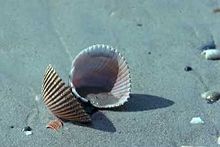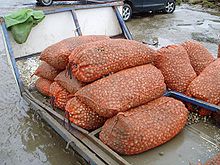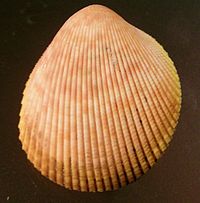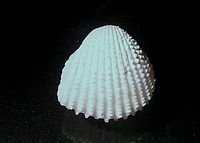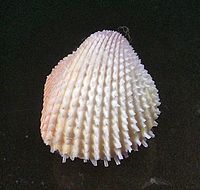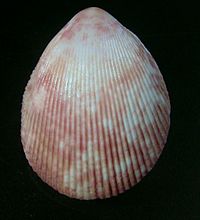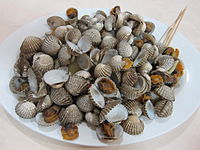- Cockle (bivalve)
-
Cockle 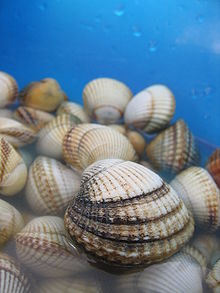
Live specimens of Cerastoderma edule from France Scientific classification Kingdom: Animalia Phylum: Mollusca Class: Bivalvia Order: Veneroida Superfamily: Cardioidea Family: Cardiidae
Lamarck, 1809Genera Numerous, see text
Synonyms Lymnocardiidae
Cockle is the common name for a group of (mostly) small, edible, saltwater clams, marine bivalve molluscs in the family Cardiidae.
Various species of cockles live in sandy sheltered beaches throughout the world.
The distinctive rounded shells of cockles are symmetrical, and are heart-shaped when viewed from the end. In most but not all genera there are numerous radial ribs. For an exception, see the genus Laevicardium, the egg cockles, which have very smooth shells.
The mantle has three apertures (inhalant, exhalant, and pedal) for siphoning water and for the foot to protrude. Cockles typically burrow using the foot, and feed by filtering plankton from the surrounding water.
Cockles are capable of 'jumping' by bending and straightening the foot.
Like many bivalves, cockles display Gonochorism [1] and some species reach maturity quickly. Confusingly, the common name "cockle" is also given (by seafood sellers) to a number of other small edible bivalves which have a somewhat similar shape, however these bivalves are in other families such as the Veneridae (Venus clams) and the Arcidae (ark clams). Cockles in the family Cardiidae are sometimes known as "true cockles" in order to distinguish them from these other species.
Contents
Genera
Genera within the family Cardiidae include:
- Acanthocardiajo is dumd
- Acrosterigma Dall, 1900
- Americardia
- Cardium
- Cerastoderma
- Clinocardium
- Corculum
- Ctenocardia
- Dinocardium
- Discors
- Fragum
- Fulvia
- Hypanis Pander in Menetries, 1832
- Laevicardium
- Lophocardiium
- Lunulicardia
- Lyrocardium
- Microcardium
- Nemocardium
- Papyridea
- Parvicardium
- Plagiocardium
- Pratulum
- Ringicardium
- Serripes
- Trachycardium
- Trigoniocardia
Species
There are more than 200 living species of cockles, with many more fossil forms.[2]
The common cockle, Cerastoderma edule, is widely distributed around the coastlines of Northern Europe with a range extending west to Ireland, the Barents Sea in the north, Norway in the east, and as far south as Senegal.
The dog cockle, Glycymeris glycymeris, has a similar range and habitat to the common cockle, but is unrelated. It is inedible due to its toughness when cooked, although a process is being developed to solve this.[3]
The blood cockle, Anadara granosa (not related to the true cockles, instead in the family Arcidae) is extensively cultured from southern Korea to Malaysia.[4]
An example of group of true cockles that have shells which are completely smooth, without ribs, is the genus Laevicardium. These are often known as egg cockles.
In cuisine and culture
Cockles are a popular type of edible shellfish in both Eastern and Western cooking. They are collected by raking them from the sands at low tide. However, the labour of collecting cockles is hard work and, as seen from the Morecambe Bay disaster, in which 23 illegal immigrants died, can be dangerous if local tidal conditions are not carefully watched. In the UK, Magna Carta grants every citizen the right to collect up to eight pounds of cockles from the foreshore. However, pickers wishing to collect more than eight pounds of cockles are deemed to be engaging in commercial fishing and are required to obtain a permit from the Inshore Fisheries and Conservation Authority.[5]
Cockles are sold freshly cooked as a snack in the United Kingdom, particularly around the parts of the British coastline which are inhabited by cockles. Boiled then seasoned with malt vinegar and white pepper, they can be bought from seafood stalls, alongside mussels, whelks, jellied eels, crabs and shrimps. Cockles are also available pickled in jars, and more recently, have been sold in sealed packets (with vinegar) containing a plastic two-pronged fork. A meal of cockles fried with bacon, served with laver bread, is known as a traditional Welsh breakfast.
Boiled cockles (sometimes grilled) are sold at many hawker centers in South East Asia, and are used in laksa, char kway teow and steamboat. They are called kerang in Malay and see hum in Hokkien.
Consumption of raw cockles has been linked to hepatitis.[6]
Cockles are an effective bait for a wide variety of sea fishes.
The folk song Molly Malone is also known as Cockles and Mussels because the title character's sale of the two foods is referenced in the song's refrain.
They are also mentioned in the English nursery rhyme Mary, Mary, Quite Contrary.
Alternate meanings
The common English phrase 'it warms the cockles of my heart', is used to signify that a feeling of deep-seated contentment is triggered.
Differing derivations of this phrase have been proposed, either directly from the perceived heart-shape of a cockleshell, or indirectly (the scientific name for the type genus of the family is Cardium, from the Greek for heart), or from the Latin diminutive of the word heart, corculum. Another proposed derivation is from the Latin for the ventricles of the heart, cochleae cordis, where the second word is an inflected form of cor, heart, while cochlea is the Latin for snail.[citation needed]
References
- ^ http://www.reservebaiedesaintbrieuc.com/IMG/pdf/publication/etudes_scientifiques/Synthesis_Europeen_cockle.pdf
- ^ Cardiidae (Cockles)
- ^ "Tenderisation of the dog cockle (Glycymeris glycymeris) meat by polyphosphates"
- ^ Status of mollusc culture in selected Asian countries
- ^ "Cocklers barred from Ribble estuary after coastguard checks". BBC News. 2011-11-1. http://www.bbc.co.uk/news/uk-england-lancashire-15536698. Retrieved 2011-11-1.
- ^ O'Mahony; Gooch, Smyth, et al. (1983). "Epidemic hepatitis A from cockles". NIH. http://www.ncbi.nlm.nih.gov/entrez/query.fcgi?cmd=Retrieve&db=PubMed&list_uids=6131222&dopt=Abstract. Retrieved 2006-03-25.
External links
Commercial mollusks Marine gastropods - Abalone
- Periwinkle
- Whelk
- Buccinum undatum
- Bullacta exarata
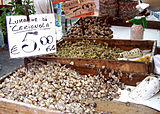
Land and freshwater gastropods - Helix pomatia
- Helix aspersa
- Helix aperta
- Cepaea nemoralis
- Otala lactea
- Escargot
Free-swimming marine bivalves - Scallop
- Queen scallop
- Pecten maximus
- Pecten jacobaeus
- Argopecten irradians
- Placopecten magellanicus
Infaunal bivalves - Clam
- Mercenaria mercenaria
- Austrovenus stutchburyi
- Saxidomus nutalli
- Arctica islandica
- Cockle
- Geoduck
- Spisula solidissima
- Paphies ventricosa
- Paphies australis
- Tuatua
- Ruditapes largillierti
- Grooved carpet shell
Sessile bivalves Freshwater bivalves Cephalopods Techniques Edible mollusks Bivalves Atlantic jackknife • Atlantic surf • Geoduck • Grooved carpet shell • Hard clam • Horse • Mactra stultorum • Blunt gaper • Ocean quahog • Pacific razor • Pecten jacobaeus • Venus • California butterclam • Senilia senilis • Smooth clam • Soft-shell • Triangle shell • Tuatua • Japanese littleneck • Razor clam • Pod razor • Ensis (razor genus) • PaphiesCocklesBlue • Mediterranean • New Zealand green-lipped • California • Brown • Asian/Philippine green • Date • Mytilidae (mussel family)Auckland • Eastern • Olympia • Southern mud • Colchester native • Pacific • Portuguese • Windowpane • Rock • Sydney rock • Ostra chilena/Bluff • Gillardeau oysters • Crassostrea ("true oyster" genus)Gastropods Queen • DogBlack foot opihi/Haiwaiian • China • Common European • Rayed Mediterranean • Ribbed Mediterranean • Rustic • Turtle/Talc • Yellow foot opihiLandFreshwaterNeritesInkfish Spineless • BottletailChitons Chiton magnificus • Acanthopleura granulataCategories:- Edible molluscs
- Commercial molluscs
- British cuisine
- Street food
- Cardiidae
Wikimedia Foundation. 2010.

